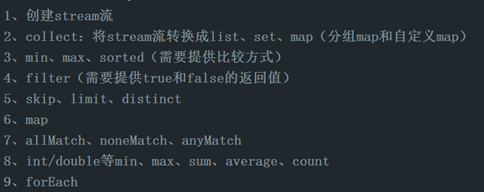六、Stream流
1、 什么是stream流
现阶段,可以把stream流看成一个高级版的Iterator。普通的Iterator只能实现遍历,遍历做什么,就需要具体些功能代码函数了。而这个stream可以实现一些遍历常见的功能(例如:非空、求最大值、遍历打印等)
2、 效率高吗?
采用lazy模式(懒处理模式),所有操作最后一起执行,在一次循环中结束。
3、 创建stream流
1) list集合
list对象.stream()即可
2) 数组
Arrays.stream(数组对象)
或者
Stream.of(数组对象)
4、 常见的方法

例如:
package com.lennar.jdk8learn.learn;
import lombok.AllArgsConstructor;import lombok.Data;import lombok.NoArgsConstructor;import org.junit.Test;import java.util.*;import java.util.stream.Collectors;import java.util.stream.Stream;public class LeanStream { @Test public void test1() { List<String> list = new ArrayList<>(); String[] strings = new String[10]; for (int i = 0; i < 10; i++) { list.add(String.valueOf(i)); strings[i] = String.valueOf(i); } //创建流stream Stream listStream = list.stream(); Stream arrayStream = Arrays.stream(strings); Stream arrayStream2 = Stream.of(strings); //forEach遍历方法 listStream.forEach(System.out::println); System.out.println("---------------"); arrayStream.forEach(System.out::println); System.out.println("---------------"); arrayStream2.forEach(System.out::println); System.out.println("---------------"); } @Test public void test2() { Student student1 = new Student("1", "张三", "唐山"); Student student2 = new Student("2", "李四", "唐山"); Student student3 = new Student("3", "王五", "北京"); Student student4 = new Student("4", "赵六", "杭州"); List<Student> list = new ArrayList<>(); list.add(student1); list.add(student1); list.add(student2); list.add(student3); list.add(student4); //collect方法:将Steam流转换成list、set、map List<Student> newList = list.stream().collect(Collectors.toList()); System.out.println(newList); Set<Student> set = list.stream().collect(Collectors.toSet());//去重 System.out.println(set); //Collectors.toMap(获取key的方法,获取value的方法,key相同时的方法) Map<String, Student> map = list.stream().collect(Collectors.toMap(Student::getName, student -> student, (k1, k2) -> k1));//name作key,student对象作value,键相同则取前者。 System.out.println(map); Map<String, Student> map2 = list.stream().collect(Collectors.toMap(Student::getId, student -> student, (k1, k2) -> k1)); System.out.println(map2); Map<String, Student> map3 = list.stream().collect(Collectors.toMap(Student::getAddress, student -> student, (k1, k2) -> k2)); System.out.println(map3); //Collectors.groupingBy(获取分组key的方法) Map<String, List<Student>> groupMap = list.stream().collect(Collectors.groupingBy(Student::getId)); System.out.println(groupMap); Map<String, List<Student>> groupMap2 = list.stream().collect(Collectors.groupingBy(Student::getName)); System.out.println(groupMap2); Map<String, List<Student>> groupMap3 = list.stream().collect(Collectors.groupingBy(Student::getAddress)); System.out.println(groupMap3); //最大max(里面本质就是一个Comparator的方法)、最小min(里面本质就是一个Comparator的方法) //Comparator.comparing(获取要比较的属性的方法) Optional<Student> minStudentOptional = list.stream().min(new Comparator<Student>() { @Override public int compare(Student o1, Student o2) { return -o1.getId().compareTo(o2.getId()); } }); Student minStudent = minStudentOptional.get(); System.out.println("min:" + minStudent); Optional<Student> maxStudentOptional = list.stream().max(Comparator.comparing(Student::getId)); Student maxStudent = maxStudentOptional.get(); System.out.println(maxStudent); //排序sorted(里面本质就是一个Comparator的方法) List<Student> students = list.stream().sorted(new Comparator<Student>() { @Override public int compare(Student o1, Student o2) { return -o1.getId().compareTo(o2.getId()); } }).collect(Collectors.toList()); System.out.println(students); List<Student> students2 = list.stream().sorted(Comparator.comparing(Student::getId)).collect(Collectors.toList()); System.out.println(students2); //过滤filter(里边返回一个boolean类型数据就行) List<Student> filterList = list.stream().filter(student -> { boolean flag = false; if (!student.getAddress().equals("唐山")) { flag = true; } else { if (!student.getId().equals("1")) { flag = true; } } return flag; }).collect(Collectors.toList()); System.out.println(filterList); //limit(n),仅仅研究前n个 List<Student> limitList = list.stream().limit(2).collect(Collectors.toList()); System.out.println(limitList); //skip(n),跳过前n个 List<Student> skipList = list.stream().skip(2).collect(Collectors.toList()); System.out.println(skipList); //distict(),去重 List<Student> distinctList = list.stream().distinct().collect(Collectors.toList()); System.out.println(distinctList); //map(把原内容变成新内容的方法)--其实就是获得一个新流 List<String> nameList = list.stream().map(student -> student.getName()).collect(Collectors.toList()); System.out.println(nameList); //allMatch(匹配方法lambda表达式),都匹配返回true;对每一个元素判断,最后取交集 Boolean f1 = list.stream().allMatch(student -> { boolean flag = false; if (null == student.getName()) { flag = true; } return flag; }); System.out.println(f1); //anyMatch(匹配方法lambda表达式),有元素匹配返回true;对每一个元素判断,最后取交集 boolean f2 = list.stream().anyMatch(student -> { boolean flag = false; if ("张三".equals(student.getName())) { flag = true; } return flag; }); System.out.println(f2); //noneMatch(匹配方法lambda表达式),都不匹配返回true;对每一个元素判断,最后取交集 boolean f3 = list.stream().noneMatch(student -> { boolean flag = false; if ("唐山".equals(student.getAddress())) { flag = true; } return flag; }); System.out.println(f3); } @Test public void test3() { List<Integer> list = new ArrayList<>(); for (int i = 1; i <= 100; i++) { list.add(i); } IntSummaryStatistics collect = list.stream().collect(Collectors.summarizingInt(value -> value)); System.out.println(collect.getSum()); System.out.println(collect.getMax()); System.out.println(collect.getMin()); System.out.println(collect.getAverage()); System.out.println(collect.getCount()); List<Double> list2 = new ArrayList<>(); for (int i = 1; i <= 100; i++) { list2.add((double) i); } DoubleSummaryStatistics collect2 = list2.stream().collect(Collectors.summarizingDouble(value -> value)); System.out.println(collect2.getSum()); System.out.println(collect2.getMax()); System.out.println(collect2.getMin()); System.out.println(collect2.getAverage()); System.out.println(collect2.getCount()); } } @Data @NoArgsConstructor @AllArgsConstructorclass Student { private String id; private String name; private String address; }